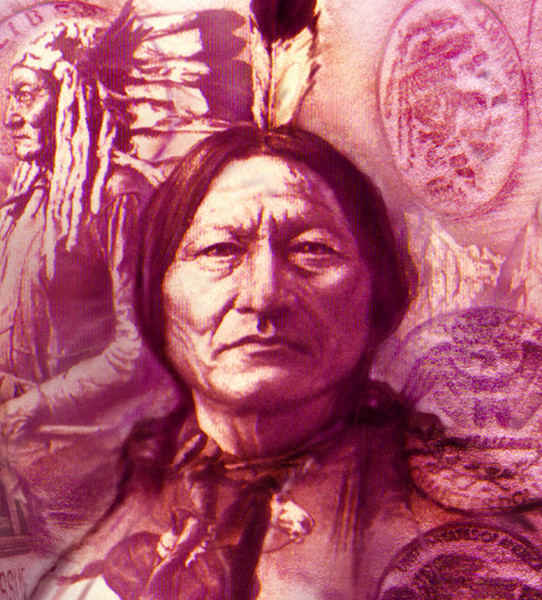- Hector Rios - Arternatives
- View Portfolio
- Image 165 of 195
- Added 05 Oct 2006
- 673 Views
- 1 Favorite
- Share This Image On...

This illustration was carefully composed of several ink drawings including postal stamps and US coin lead rubbings (buffalo nickels and quarters). I then ran the variable tones through digital textured filters to appear antiquated, airbrushing and blendings, finalizing the design by shadings, emphasized values and highlights. This is an editorial portrait I composed and painted of Chief Sitting Bull a few years ago. The title is "When The Eagle Slew The Byson". ----------------------- Inititiated as a direct commentary on my studies on native American Indians (semetic descendants of Biblical "Shem") and the method of systematic European territorial conquering. I spent various moments with representatives from the Chumash, Apache, Comanche, Yaki, Sioux etc. in reserved settings, sights and dialogues as well as asking various questions, viewing various reports, photos and later writings in order to prepare this illustration presentation for young people. Sitting Bull (also known as Tatanka-Iyotanka) was honored as the principle chief and holyman of the Teton Hunkpapa Lakota (Sioux) Nation in 1867. "The Sioux Indians lived on the wide expanse of the mid-western plains in Dakota Country States during the 19th century westward expansion of American settlers. The Sioux regularly hunted buffalo for food and developed an indispensible respect for them and system of rationing and utilizing this magnificent beasts entire body including the meat, fat, hide, hoofs, blood and even the animals defecation as fuel. Sioux's crafted these burley byson hides into terrific tall teepees, clothing articles, weapons and shields, and musical instruments including war drums. Buffalo bones and ribcages were used for sleds, carved cups, dishes, tools, hair accessories and children's toys. Upon what was considered the "pale face prophetic invasion", he entered very many battles in protection of the land and regional margins invaded, and in direct resistance to being forced into these new US government reservations. He earned a reputation as a fearless warrior, leading thousands of fighters from united tribes in battle, including the infamous triumph "Custer's Last Stand" against General George Armstrong Custer, where all that was left standing was a single horse. Sitting Bull kept his momentum, defense and determination even beyond his final tribal surrender to the US Army in 1881. Sitting Bull was not moved by threats, offers, deceptive deals and fair complacent words, rather, he stood for his ancient people and free unbridled lands. When, upon extensive battles, he found that, forced beyond the borders, the Canadian government would give them limited protection but no rations or food; when he discovered that the abundantly prominent and life sustaining "buffalo" had now been all but exterminated and his starving people were already beginning to desert him; he was disheartened and contrarily compelled at last to return to Montana, then trek to Fort Buford, North Dakota, with his band of hungry, homeless, and discouraged refugees. This is, in my opinion, when the eagle slew the byson. After 2 years in prison, he was made a touring spectacle and a ridiculous public legend throughout Europe and in early America, yet he seems to have maintained his inner principles and indigenous integrity counseling other tribes and young people until his undetailed, unfortunate departure which some say ensued due to fears of another uprising. His quotes and wisdom as an elder was much sought out by other native tribes which were being subdivided and appointed by this new race who enveloped the land. Some of his quotes are as follows: * "It is not necessary for eagles to be crows..." * "Is it wrong for me to love my own? Is it wicked for me because my skin is red? Because I am Sioux? Because I was born where my father lived? Because I would die for my people and my country?..." * "What white man has ever seen me drunk? Who has ever come to me hungry and left me unfed? Who has seen me beat my wives or abuse my children? What law have I broken?..." * "God made me an Indian. If the Great Spirit had desired me to be a white man, he would have made me so in the first place." Tatanka-Iyotanka was a real breathing human being that is still remembered for his rare valiantry, vision and values. ---------------------------------------- H Rios (213) 435-9611 Arternatives
Post a New Image Comment